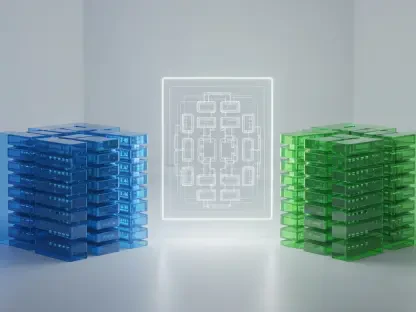In today’s rapidly evolving technological landscape, striking the right balance between software elegance and computational efficiency can be crucial for enterprise applications. Vijay Raina, an expert in enterprise SaaS technology and software design, joins us to delve into the fascinating complexity and beauty of the Mandelbrot set, a fractal that serves both mathematicians and computing specialists as a benchmark of performance prowess.
What is the Mandelbrot set, and why is it considered a computational challenge?
The Mandelbrot set is an intriguing mathematical object defined in the complex plane. It’s a set of points—essentially “journey numbers”—that, when iterated through a specific function, stay bounded within a certain distance. The challenge largely stems from its iterative nature; each point requires numerous calculations to determine its behavior, testing the limits of computational power and precision.
How is the Mandelbrot set defined in mathematical terms?
Mathematically, the Mandelbrot set involves iterating a function given by f(z) = z² + c, where z starts at zero and c is the point under consideration. The fascinating part is how the absolute value of z must stay below 2 through countless iterations. This depiction creates a boundary that defines whether a point belongs to the Mandelbrot set.
Can you explain the journey analogy used to describe the Mandelbrot set?
Imagine starting at zero, squaring this number, adding a “journey number” repeatedly, and observing where it leads. Points that remain close to zero illustrate a “well-behaved journey,” while those that explode away form an “explosive journey.” This journey analogy mirrors the iterative process mathematically, making it easier to conceptualize the paths formed by different numbers.
What distinguishes well-behaved journeys from explosive journeys in the context of the Mandelbrot set?
Well-behaved journeys are defined by a sequence of values that stays near the start. If this sequence remains bounded, the point lies within the Mandelbrot set. Conversely, explosive journeys show values that grow exponentially, indicating they do not belong in the set—and this difference is elegantly reflected through visualizations where bounded points form dark regions, and explosive growth translates into colorful displays.
How can the Mandelbrot set be used as a benchmark for computing performance?
The virtue of using the Mandelbrot set as a benchmark lies in its simplicity and complexity. It delivers a standardized way to test computational efficiency, precision, and floating-point arithmetic, all necessary components for modern software environments. Its output is consistent across platforms, facilitating comparative analysis in a visually intuitive manner.
What makes it a compelling approach compared to other benchmarking tools?
Unlike some benchmarks that focus narrowly on single aspects like arithmetic operations, the Mandelbrot set evaluates a broad spectrum, including loop optimization and memory management. This thoroughness, combined with the possibility for adjusting parameters like pixel resolution and iteration counts, provides an adaptable yet challenging benchmark across different computing scenarios.
What aspects of programming language performance does it help evaluate?
The Mandelbrot set scrutinizes various language capabilities—precision, execution speed, and optimization possibilities. It urges developers to engage with their language’s floating-point handling and enables a deeper exploration of computational resource management, both essential for any performance-critical application.
Describe the visualization process of the Mandelbrot set.
Visualizing the Mandelbrot set involves translating its complex calculations into a colorful representation. Each pixel in an image represents a unique point, calculated rigorously to decide its color based on the growth speed of the corresponding sequence. This method transforms mathematical iterations into a stunning visual tapestry.
What do the different colored regions in a Mandelbrot set visualization represent?
Different colors signify the growth rate of sequences at each point. Points within the Mandelbrot set appear black, indicating bounded growth. Meanwhile, points outside the set exhibit colors based on their divergence speed—slower growth reflects blue or purple shades, whereas rapid growth demonstrates red or yellow hues.
How is each pixel’s color determined based on its calculation result?
The coloring hinges on iterative counts—how soon does a sequence surpass bounds indicates its color. The faster it does, the brighter and more intense the color applied to that pixel, creating a vivid representation that mirrors the underlying mathematical properties.
Why is generating a visual representation of the Mandelbrot set computationally intensive?
Constructing this visual display involves computing intricate sequences for each pixel’s coordinates in high resolution. With millions of pixels requiring thousands of iterations each, the volume of calculations skyrockets, demanding both computational heft and precision, as small numerical errors may distort the dynamic fractal image.
What factors contribute to the volume of calculations needed?
High-resolution images consist of potentially millions of pixels, each involving detailed calculations. Moreover, iterative checks for bounded sequences necessitate each pixel’s unique processing path, amplifying the computational load required for an accurate rendering.
Why is precision important when calculating the Mandelbrot set?
Precision ensures the integrity of fractal boundaries, preventing the misrepresentation of numbers and consequently distorting the visual outcome. Precise calculations maintain the detailed structure and preserve the mathematical beauty inherent in the fractal.
Why can’t shortcuts be used during the calculations for each pixel?
Shortcut tactics could lead to inaccuracies in determining sequence behavior, resulting in false visuals. Thorough calculations uphold the definition of each point, ensuring that the iterative exploration thoroughly delineates boundaries without assumption.
Discuss the implementation of the Mandelbrot set for benchmarking purposes.
Implementing the Mandelbrot set for benchmarking mandates a refined approach, standardizing parameters to check computational efficiency consistently. This involves setting unified image dimensions, iteration limits, and precision standards to gauge a program’s effectiveness and resource management.
What parameters need to be standardized to ensure effective benchmarking?
Generalizing parameters such as image resolution, iteration maxima, and arithmetic precision promotes equitable benchmark conditions, enabling comparisons that reflect true software performance without disparate influences skewing results.
What performance metrics should be evaluated when using the Mandelbrot set as a benchmark?
Key metrics include execution time, memory usage, and computational load distribution. These measures provide ample insight into functional efficiency, helping identify strengths and potential bottlenecks within a specific environment.
How can one evaluate both technical performance and implementation complexity?
Balancing both aspects involves not just benchmarking raw computation but examining code quality, development ease, and optimization strategies. This holistic view reveals a deeper understanding of the tools at hand, harmonizing technical efficiency with practical implementation demands.
What additional benchmarks might you consider alongside the Mandelbrot set for a complete evaluation of language performance?
Diversifying benchmarks by integrating tests focused on I/O operations, concurrency handling, and database performance can amplify insights. This comprehensive approach complements the Mandelbrot set’s focus and broadens the evaluation scope.
How does the Mandelbrot set measure raw computational power and floating-point performance?
The Mandelbrot set challenges systems with rigorous floating-point operations and iterative demands, effectively testing both arithmetic precision and computational speed, two pillars of raw performance metrics.
What benefits could be gained by supplementing the Mandelbrot set benchmark with other tests?
Supplementing the Mandelbrot set with diverse evaluations can address gaps, ensuring a nuanced analysis. They capture broader performance variables, enhancing decision-making through an enriched profile of language capabilities.
Why might artists also be interested in the Mandelbrot set, aside from its computational aspects?
Beyond mathematical allure, the Mandelbrot set offers mesmerizing visuals that intrigue artists with its symmetrical beauty and complex color gradients. These images evoke creativity and inspire artistic exploration by visualizing abstract mathematical principles.
What is your forecast for computational benchmarking, particularly with complex objects like the Mandelbrot set?
In computational benchmarking’s future, leveraging rich, complex models like the Mandelbrot set will remain relevant as computing grows more advanced. It offers an inventive way to drive innovation, marry artistry with precision, and continually challenge programming methodologies and architectures.









